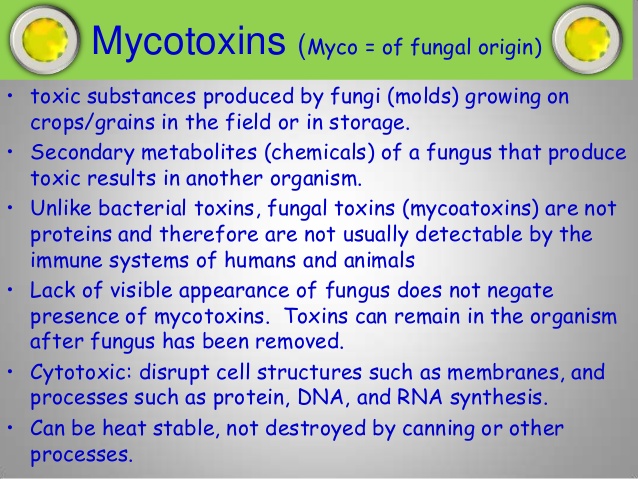
Table of Contents
1. Introduction
2. Mycotoxins and their Contamination
3. Major Mycotoxins and their Effects on Health
4. Sources of Mycotoxin Contamination
5. Methods of Detection and Analysis
6. Limitations of Conventional Mycotoxin Detection Methods
7. Membrane-Based Immunoassays for Mycotoxin Detection
8. Detection of AFB1 and OA using Membrane-Based Immunoassays
9. Selective Removal of Nonspecific Interfering Substances
10. Conclusion
Mycotoxins are low molecular weight compounds which are produces as secondary metabolite by filamentous fungi. Mycotoxin contamination is one of the most common problems concerning the food safety. They can occur in frequently in different foods at different combination and pose a greater degree of health damage. The major mycotoxins are Aflatoxin, Ochratoxin, Fumonisin B1 or zearalenone (ZEN).
They are found mostly in different crops like cereals, nuts, spices, dried fruits, wine and coffee, According to The Food and Agriculture Organization of the United Nations (FAO), it is estimated that roughly 25% world’s food is contaminated with mycotoxin with an estimated loss of billion dollars. Fungal strains like Aspergillus, Penicillium, or Fusarium are important in respect to mycotoxin production which can invade the food crops both in pre harvest and postharvest stage. Human risks to mycotoxin are associated with direct consumption of food contaminated with mycotoxin.
A number of studies identified mycotoxins as etiological factors responsible for number of disorder like problems related to respiratory and neurology, cancerous changes, nephrotoxicity and also hepatotoxicity. The International Agency for Research on Cancer‘s (IARC) and the U.S. National Toxicology program have reviewed mycotoxins and then graded the cancer risk posed to humans.
Since the discovery of mycotoxins, several methods have been developed and validated for the detection and analysis of mycotoxins in food and feed like thin layer chromatography (TLC); high performance liquid chromatography (HPLC) coupled with detection method like UV or MS; gas chromatography (GC) coupled with ECD, FID or MS detection; Ultra Performance Liquid Chromatography (UPLC); enzyme-linked immunosorbent assay (ELISA); and rapid strip screening tests. However, despite the tremendous progress, in detection method there are still major improvements are required in the areas like detection of low level mycotoxin contamination or where there are several mycotoxin coexist together.
Additionally, the conventional mycotoxin detection methods requires few hours to days to analyse the sample, whereas increased analytical complexity in food industry need to go for a rapid report for each food sample analysed. Additionally, traditional methods require long extraction procedures, expensive chemical clean-up methods and hazardous chemicals. Due to such conditions, rapid analyses of mycotoxins are more favourable and which prompt to the development of test kits that can qualitatively or quantitatively provide. rapid, inexpensive and reliable results for the detection of mytotoxin contamination on site.
Aspergillus flavus (left), Aspergillus flavus growing on corn (middle), chemical structure of aflatioxin B1 (right)
Membrane based immunoassays are now widely used for the detection of small molecules like mycotoxins. The approach is based on the competitive reaction between an unlabelled antigen (analyte) and a labelled antigen against a limited amount of immobilized anti-hapten antibody. These assays always yield ―typical‖ competitive inhibition results, meaning the decrease of the signal with increasing analyte concentration.
Among different mycotoxins, AFB1 and OA are quite common contaminants, which can be found jointly in a wide range of food commodities including spices. The European Scientific Committee for food has fixed the legal limit for AFB1 at 5µg /kg for spices. Whereas, there is currently no legal limit for OA, the European Commission has been discussing a limit of 10µg/ kg in spices.
This method was more economical in relation to time, work and materials. The method uses a low cost test device consisting of a membrane with immobilized anti-AFB1 and anti-OA antibodies and a filter paper attached to a polyethylene card below the membrane- The limit of quantitation obtained was 2 and 10 µg/ kg for AFB1 and OA, respective. Similarly the membrane based methods are also useful for detection of OA in wine and coffee samples with the elimination of matrix interferences in the within the same immunoassay platform.
This can be easily done with selective removal of nonspecific interfering substances from the sample extract during the assay. The method is useful for the detection of OA in wine and coffee with a detection limit of 1 μg/L and 2.5 μg /Kg respectively which is more sensitive than the available membrane-based immunoassays methods.
References
- A review of rapid methods for the analysis of mycotoxins. Michael Z. Zheng, John L. Richard& Johann Binder. Mycopathologia (2006) 161: 261–273.
- Mycotoxins – Limits and Regulations. Mazumder PM and Sasmal D. Anc Sci Life. 2001 20(3): 1–19.
- Determining Mycotoxins and Mycotoxigenic Fungi in Food and Feed. Y. Goryacheva
- De Saeger. A volume in Woodhead Publishing Series in Food Science, Technology and Nutrition. 2011, Pages 135–167-
- Mycotoxins in Food and Feed: Present Status and Future Concerns. Bhat R, Ravisankar, VI and Karim AA. Comprehensive Reviews in Food Science and Food Safety.
- Saha, D., Acharya, D., Roy, D., Srestha, D. and Dhar, T.K. (2007): Development of a rapid analytical method for the simultaneous determination of aflatoxin B1 and ochratoxin A in chilies by simple flow-through enzyme. Analytica Chimica Acta. 584(2), 343-349. (IF: 4.513)
- Saha, D., Acharya, D., Roy, D. and Dhar, T.K. (2007): Filtration-based tyramide amplification technique: A new simple approach for rapid detection of aflatoxinB1. Analytical Bioanalytical Chemistry 387(3), 1121-1130.
- Saha, D., Acharya, D. and Dhar, T.K. (2006): An improved method for homogeneous spotting of antibody on membranes and its application for sensitive detection of ochratoxin A without sample cleanup. Analytical Bioanalytical Chemistry 385(5) , 847-854.
Related Products
OTA (Ochratoxin A), ELISA Kit (#MBS2548743)
Ochratoxin A, HRP Conjugate (#MBS342274)
Ochratoxin-A (OCH-A), ELISA Kit (#MBS2610255)
Aflatoxin, Hapten Conjugate (#MBS5307971)
AF (Aflatoxin), Rapid Test Kit (#MBS2548740)



